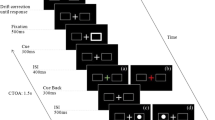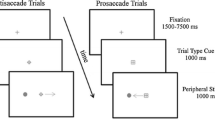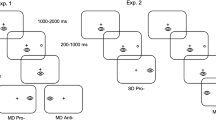Abstract
Several studies have shown that anti-saccades, more than pro-saccades, are executed under executive control. It is argued that executive control subsumes a variety of controlled processes. The present study tested whether some of these underlying processes are involved in the execution of anti-saccades. An experiment is reported in which two such processes were parametrically varied, namely input monitoring and response selection. This resulted in four selective interference conditions obtained by factorially combining the degree of input monitoring and the presence of response selection in the interference task. The four tasks were combined with a primary task which required the participants to perform either pro-saccades or anti-saccades. By comparison of performance in these dual-task conditions and performance in single-task conditions, it was shown that anti-saccades, but not pro-saccades, were delayed when the secondary task required input monitoring or response selection. The results are discussed with respect to theoretical attempts to deconstruct the concept of executive control.

Similar content being viewed by others
Notes
This could be taken as an indication that the effects of input monitoring and response selection are not additive. Peculiar about this interaction is that the combination of fixed presentation with the simple RT task tends to be slower than the combination of the random presentation with simple RT. The former combination is more vulnerable to the occurrence of anticipatory responses. It seems quite likely that after an anticipation, the next response is slowed resulting in a slower response on average.
References
Allain, S., Carbonnell, L., Burle, B., Hasbroucq, T., & Vidal, F. (2004). On-line executive control: An electromyographic study. Psychophysiology, 41, 113–116.
Baddeley, A. (1996). Exploring the central executive. Quarterly Journal of Experimental Psychology, 49A, 5–28.
Baddeley, A. D., & Hitch, G. (1974). Working memory. In G. H. Bower (Ed.) The psychology of learning and motivation (Vol. 8, pp.47–89). NewYork: Academic.
Briand, K. A., Strallow, D., Hening, W., Poizner, H., & Sereno, A. B. (1999). Control of voluntary and reflexive saccades in Parkinson’s disease. Experimental Brain Research, 129, 38–48.
Burgess, P. W. (1997). Theory and methodology in executive function research. In P. Rabbitt (Ed.) Methodology of frontal and executive function (pp. 81–116). Hove: Psychology Press.
Carbonnell, L., Hasbroucq, T., Grapperon, J., & Vidal, F. (2004). Response selection and motor areas: A behavioural and electrophysiological study. Clinical Neurophysiology, 115, 2164–2174.
Deschuyteneer, M., & Vandierendonck, A. (2005a). Are ‘input monitoring’ and ‘response selection’ involved in solving simple mental additions. European Journal of Cognitive Psychology, 17, 343–370.
Deschuyteneer, M., & Vandierendonck, A. (2005b). The role of “response selection” and “input monitoring” in solving simple arithmetical products. Memory & Cognition, 33, 1472–1483.
Deschuyteneer, M., Vandierendonck, A., & Coeman, P. (2005). Exploring the role of different executive processes in solving simple mental subtractions and divisions (submitted for publication).
Deschuyteneer, M., Vandierendonck, A., & Muyllaert, I. (2006). Does solution of mental arithmetic problems such as 2 + 6 and 3 × 8 rely on the process of ‘memory updating’? Experimental Psychology (in press).
Eenshuistra, R. M., Ridderinkhof, K. R., & van der Molen, M. W. (2004). Age-related changes in anti-saccade task performance: Inhibitory control or working-memory engagement? Brain and Cognition, 56, 177–188.
Everling, S., & Fischer, B. (1998). The anti-saccade: a review of basic research and clinical studies. Neuropsychologia, 36, 885–899.
Feifel, D., Farber, R. H., Clementz, B. A., Perry, W., & Anllo-Vento, L. (2004). Inhibitory deficits in ocular motor behavior in adults with attention-deficit/hyperactivity disorder. Biological Psychiatry, 56, 333–339.
Findlay, J. M., & Walker, R. (1999). A model of saccade generation based on parallel processing and competitive inhibition. Behavioral and Brain Sciences, 22, 661–721.
Frith, C. D., & Done, D. J. (1986). Routes to action in reaction-time tasks. Psychological Research-Psychologische Forschung, 48, 169–177.
Fukushima, J., Fukushima, K., Miyasaka, K., & Yamashita, I. (1994). Voluntary control of saccadic eye movement in patients with frontal cortical lesions and Parkinsonian patients with thatin schizophrenics. Biological Psychiatry, 36, 21–30.
Guitton, D., Buchtel, H. A., & Douglas, R. M. (1985). Frontal lobe lesions in man cause difficulties in suppressing reflexive glances and in generating goal-directed saccades. Experimental Brain Research, 58, 455–472.
Hallett, P. E. (1978). Primary and secondary saccades to goals defined by instructions. Vision Research, 18, 1279–1296.
Hallett, P. E., & Adams, B. D. (1980). The predictability of saccadic latency in a novel voluntary oculomotor task. Vision Research, 20, 329–339.
Hamilton, A. C., & Martin, R. C. (2005). Dissociations among tasks involving inhibition: A single-case study. Cognitive, Affective, & Behavioral Neuroscience, 5, 1–13.
Henik, A., Rafal, R., & Rhodes, D. (1994). Endogenously generated and visually guided saccades after lesion of the human frontal eye fields. Journal of Cognitive Neuroscience, 6, 400–411.
Hutton, S. B., Huddy, V., Barnes, T. R. E., Robbins, T. W., Crawford, T. J., Kennard, C., & Joyce, E. M. (2004). The relationship between anti-saccades, smooth pursuit, and executive dysfunction in first-episode schizophrenia. Biological Psychiatry, 56, 553–559.
Kane, M. J., Bleckley, M. K., Conway, A. R. A., & Engle, R. W. (2001). A controlled-attention view of working-memory capacity. Journal of Experimental Psychology: General, 130, 169–183.
Klein, C. (2001). Developmental functions for saccadic eye movement parameters derived from pro-and anti-saccade tasks. Experimental Brain Research, 139, 1–17.
Klein, C., Heinks, T., Andresen, B., Berg, P., & Moritz, S. (2000). Impaired modulation of the saccadic contingent negative variation preceding anti-saccades in schizophrenia. Biological Psychiatry, 47, 978–990.
Koval, M. J., Ford, K. A., & Everling, S. (2004). Effect of stimulus probability on anti-saccade error rates. Experimental Brain Research, 159, 268–272.
Kristíansson, A., Chen, Y., & Nakayama, K. (2001). Less attention is more in the preparation of anti-saccades, but not pro-saccades. Nature Neuroscience, 4, 1037–1042.
Logan, G. D., & Irwin, D. E. (2000). Don’t look! Don’t touch! Inhibitory control of eye and hand movements. Psychonomic Bulletin & Review, 7, 107–112.
Massen, C. (2004). Parallel programming of exogenous and endogenous components in the anti-saccade task. Quarterly Journal of Experimental Psychology, 57A, 475–498.
Mitchell, J. P., Macrae, C. N., & Gilchrist, I. D. (2002). Working memory and the suppression of reflexive saccades. Journal of Cognitive Neuroscience, 14, 95–103.
Miyake, A., Friedman, N. P., Emerson, M. J., Witzki, A. H., Howerter, A., & Wager, T. D. (2000). The unity and diversity of executive functions and their contributions to complex “frontal lobe” tasks: A latent variable analysis. Cognitive Psychology, 41, 49–100.
Mort, D. J., Perry, R. J., Mannan, S. K., Hodgson, T. L., Anderson, E., Quest, R., McRobbie, D., McBride, A., Husain, M., & Kennard, C. (2003). Differential cortical activation during voluntary and reflexive saccades in man. NeuroImage, 18, 231–246.
Mostofsky, S. H., Lasker, A. G., Singer, H. S., Denckla, M. B., & Zee, D. S. (2001). Oculomotor abnormalities in boys with Tourette syndrome with and without ADHD. Journal of the American Academy of Child and Adolescent Psychiatry, 12, 1464–1472.
Nieuwenhuis, S., Broerse, A., Nielen, M. M. A., & de Jong, R. (2004). A goal activation approach to the study of executive function: An application to anti-saccade tasks. Brain and Cognition, 56, 198–214.
O’Driscoll, G. A., Depatie, L., Holahan, A. L. V., Savion-Lemieux, T., Barr, R. G., Jolicoeur, C., & Douglas, V. I. (2005). Executive functions and methylphenidate response in subtypes of attention-deficit/hyperactivity disorder. Biological Psychiatry, 57, 1452–1460.
Olincy, A., Ross, R. G., Youngd, D. A., & Freedman, R. (1997). Age diminishes performance on an anti-saccade eye movement task. Neurobiology of Aging, 18, 483–489.
Olk, B., Chang, E., Kingstone, A., & Ro, T. (2006). Modulation of anti-saccades by transcranial magnetic stimulation of the human frontal eye field. Cerebral Cortex, 16, 76–82.
Pearson, D. G., & Sahraie, A. (2003). Oculomotor control and the maintenance of spatially and temporally distributed events in visuo-spatial working memory. Quarterly Journal of Experimental Psychology, 56A, 1089–1111.
Philipp, A. M., & Koch, I. (2005). Switching of response modalities. Quarterly Journal of Experimental Psychology, 58A, 1325–1338.
Pierrot-Deseilligny, C., Rivaud, S., Gaymard, B., & Agid, Y. (1991). Cortical control of reflexive visually guided saccades. Brain, 114, 1473–1485.
Pierrot-Deseilligny, C., Muri, R. M., Nyffeler, T., & Milea, D. (2005). The role of the human dorsolateral prefrontal cortex in ocular motor behavior. Annals of the New York Academy of Sciences, 1039, 239–251.
Ploner, C. J., Gaymard, B. M., Rivaud-Péchoux, S., & Pierrot-Deseilligny, C. (2005). The prefrontal substrate of reflexive saccade inhibition in humans. Biological Psychiatry, 57, 1159–1165.
Roberts, R. J. Jr., Hager, L. D., & Heron, C. (1994). Prefrontal cognitive processes: Working memory and inhibition in the anti-saccade task. Journal of Experimental Psychology: General, 123, 374–393.
Rogers, R. D., & Monsell, S. (1995). Costs of a predictable switch between simple cognitive tasks. Journal of Experimental Psychology: General, 124, 207–231.
Schubert, T. (1999). Processing differences between simple and choice reactions affect bottleneck localization in overlapping tasks. Journal of Experimental Psychology: Human Perception and Performance, 25, 408–425.
Schuch, S., & Koch, I. (2003). The role of response selection for inhibition of task sets in task shifting. Journal of Experimental Psychology: Human Perception and Performance, 29, 92–105.
Spector, A., & Biederman, I. (1976). Mental set and mental shift revisited. Journal of Psychology, 89, 669–679.
Stuyven, E., Van der Goten, K., Vandierendonck, A., Claeys, K., & Crevits, L. .(2000). Saccadic eye movements under conditions of cognitive load. Acta Psychologica, 104, 69–85.
Szmalec, A., Vandierendonck, A., & Kemps, E. (2005). Response selection involves executive control: Evidence from the selective interference paradigm. Memory & Cognition, 33, 531–541.
Unsworth, N., Schrock, J. C., & Engle, R. W. (2004). Working memory capacity and the anti-saccade task: Individual differences in voluntary saccade control. Journal of Experimental Psychology: Learning, Memory, and Cognition, 30, 1302–1321.
Vandierendonck, A. (2000). Bias and processing capacity in generation of random time intervals. Cognitive Science Quarterly, 1, 205–233.
Walker, R., Husain, M., Hodgson, T. L., Harrison, J., & Kennard, C. (1998). Saccadic eye movement and working memory deficits following damage to human prefrontal cortex. Neuropsychologia, 36, 1141–1159.
Acknowledgments
Denis Drieghe is a senior research assistant of the Fund for Scientific Research-Flanders. The research reported in this article was supported by grant no. 10251101 of the Special Research Fund of Ghent University to the first author and by a PhD grant (no. 011D1201) of the same agency to the second author.
Author information
Authors and Affiliations
Corresponding author
Rights and permissions
About this article
Cite this article
Vandierendonck, A., Deschuyteneer, M., Depoorter, A. et al. Input monitoring and response selection as components of executive control in pro-saccades and anti-saccades. Psychological Research 72, 1–11 (2008). https://doi.org/10.1007/s00426-006-0078-y
Received:
Accepted:
Published:
Issue Date:
DOI: https://doi.org/10.1007/s00426-006-0078-y




